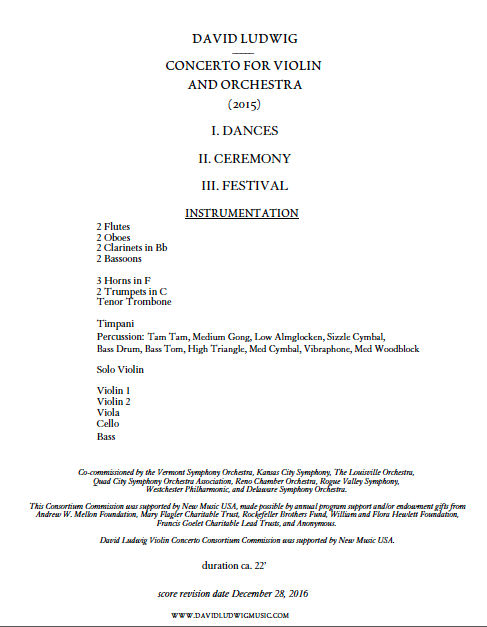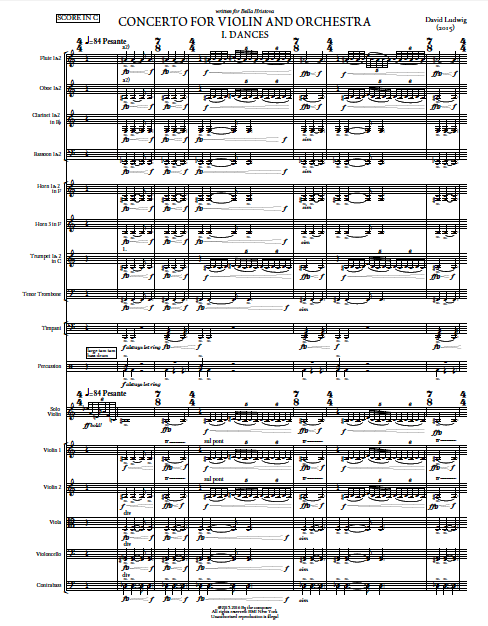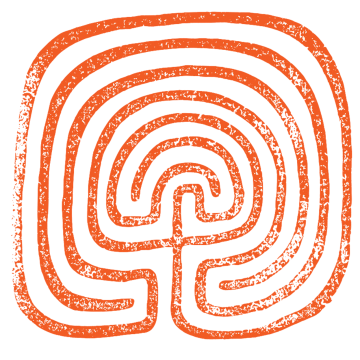


Violin Concerto
Concerto for Violin and Orchestra (2015) - 25'
- Solo violin and orchestra
- Written for Bella Hristova, solo violinist
- Commissioned by the Kansas City Symphony Orchestra, Louisville Orchestra, Quad Cities Symphony Orchestra, Vermont Symphony Orchestra, Delaware Symphony, Westchester Philharmonic, Rogue Valley Symphony, and Reno Chamber Orchestra with support from New Music USA
-Premiered in Flynn Center for the Performing Arts by Bella Hristova violin, Jaime Laredo conductor, and Vermont Symphony Orchestra; March 19, 2016
RENTAL INFORMATION
Program Listing
Concerto for Violin and Orchestra (2015)
I. Dances
II. Ceremony
III. Festival
Program Notes
I started working on my violin concerto right around the time I got married with Bella Hristova, who (without coincidence) is the violinist I wrote the piece for. I only know of a few concertos written by composers for first performances by their spouses, and I don’t know of any that are motivated by the idea of marriage itself, as this one is. My concerto comes with musical references to partnership, empathy, and communion, as it imagines the before, during, and after a traditional wedding ceremony.
Even though the violin concerto doesn’t tell a specific story, I couldn’t help but write something personal. Both of our backgrounds are Eastern European, and the piece is full of dance music from that part of the world; including several dances native to her native Bulgaria. And like me, Bella comes from a musical family; including her father, Yuri Chichkov, whom she never got a chance to meet before he passed away while she was still a child. Chichkov was a wonderful and well-known Russian composer, who himself wrote a violin concerto. After a year of hunting, I tracked down that concerto and quoted from his second movement at a place in my own second movement–as a way to include him in our marriage. There are lots of other quotes in the piece, but that one is the most significant to me.
The first movement "Dances" begins with a loud crash–a jarring but transformative start to something new that transitions into a waltz-like music soon after. All told there are four dances in the first movement, connected by a cadenza and concluded by a Rachenitsa in its traditional irregular meter. The second movement "Ceremony" follows the progression of the wedding ritual. A slow unraveling processional is woven throughout the fabric of this movement, ending in musical rings created by the rise and fall of the violin against solo instruments in the orchestra. The third movement "The Festival" is my version of a Krivo Horo or "Crooked Dance" that captures the way people attempt to walk home after a great party. The music is celebratory to the end, reflecting the coming together of a community inspired by two people promised to preserve each other’s well being for the rest of their lives.
Press
"The Concerto arrived at Kansas City’s Helzberg Hall on April 8, with Michael Stern conducting the Kansas City Symphony, and right from the start it was gratifying to notice that the piece is so deftly structured, judiciously orchestrated and gorgeously lyrical to its core that it could succeed just fine without any background story at all. After a solo-violin flourish of motivic significance and a percussive crash (which the composer says represents the “jarring but transformative start to something new” that marriage represents), the first movement (Dances) presents a series of quirky textures and rhythms of the Central- and Eastern-European variety: jagged Bartókian pyrotechnics, delightfully irregular rhythms fading in and out of danceability, and lilting waltz-like excursions set to transparent, Debussian complexity.
The centerpiece of the concerto is the slow movement (Ceremony), in which Bella’s lyric gifts were called upon for a long, arching melodic line that worked its way into the stratosphere before gently relenting. One couldn’t help but think of Shostakovich’s searing adagio melodies with all their dark yearning, and for good measure David has also woven in a tune borrowed from Bella’s father, the Russian composer Yuri Chichkov, who died when Bella was a small child. This powerful movement—with its superb lyricism, shimmering orchestration and emotional content that (oddly) seems to approach tragedy—may become the main reason that future soloists want play this concerto. As it dies into oblivion it’s as if the enormity of “I do” has set in, and the celebrants are left unsure as to how they feel about it.
The finale (The Festival) is a headstrong romp driven by perpetual-motion virtuosity from the soloist, irregular dance rhythms suggesting inebriation, and a sort of cadenza for percussion in the midst of the revelry. The chaos increases to a playful climax, then resolves with an abrupt bang.” – KC Independent
"Ludwig wrote the piece for violinist Bella Hristova, his wife, who performed the virtuosic and demanding solo part. Her dark timbre and dense fiddling suited the Eastern European influence integrated into the work.
The semi-programmatic piece was based on the wedding ritual (preparation, commitment, community celebration). Ludwig created captivating moments and effects, with ascending glissandi, sliding harmonics, off-kilter dance rhythms and unusual timbral combinations.” – Kansas City Star
"The work is an absolute musical treat. It is, in turns, delightful, elegant, pleasing and stunning. It not only presents jaw-dropping challenging virtuoso violin solo passages, but makes full and brilliant use of the entire orchestra. I am not usually at a loss for words, but Ms. Hristova’s performance of this piece pushes me awfully close. This work provided the most challenging, difficult, and magnificent violin solo passages I have ever seen/heard and I have seen a lot by numerous virtuosos. The work demands everything from the violin soloist – sweet little quiet passages, absolute command of the top of the instrument’s range, and precise skill playing an extended passage of compressed notes at an impossibly fast pace. It was a violin tour de force. And it was exceptionally well done by Ms. Hristova. Mr. Ludwig challenges the violin soloist in every way possible, and Ms. Hristova gloriously rises to meet and conquer every challenge. (If I ever had the temerity to demand that my new wife tackle something so difficult, with an auditorium full of observers, I think I’d be locked out of the bedroom for months. But the chemistry between Ms. Hristova and Mr. Ludwig is such that each apparently feeds energy and exuberance off of the other and mutually push each other to rarified new heights.) As noted already, Mr. Ludwig makes full use of the rest of the orchestra, and under Maestro Majkut’s direction, they rose to the challenge as well. The piece makes heavy use of tympani and percussion in a number of sections (for example, in the Dance section to underscore the dark mood) and the percussion section and timpanist Theresa McCoy were superlative in performing those passages. At several places, the piece includes dramatic swells from the brass and woodwind sections, which also comported themselves with aplomb. And the strings, oh the strings – the strings serve several vital roles in this work, for example they represent the bridesmaids during the ceremony in the Ceremony movement. If only every wedding could have bridesmaids so beautiful. The conclusion of the performance of the work was met with a much deserved, sustained, rousing, standing ovation by the audience, through multiple curtain calls and bows by Ms. Hristova, Maestro Majkut, composer Ludwig, and the entire orchestra.” – Performing Arts Reviews
"The concert opened with David Ludwig’s Concerto for Violin and Orchestra, with Bella Hristova as soloist. The semi-programmatic piece which was commissioned by an eight-orchestra consortium — including the DSO — celebrates Ludwig’s marriage to Hristova. Its three movements recount the wedding ritual (preparation, ceremony, celebration) within the broader themes of partnership, empathy and communion.
Ludwig invested the work with captivating moments and effects: asymmetrical rhythms, loping harmonies, ascending glissandi as well as unusual timbral combinations.
The work opens with a violin exclamation and everything a symphony orchestra can throw at it to signify transformative power of love and commitment before progressing to various Eastern-European style dances. The music builds to a brilliant raucousness, blending virtuosic cadenzas with warm lyricism.
The second movement opens with a tender melody in the solo violin that blossoms and grows joyful. This section serves as a touching tribute to the father Hristova never knew, Soviet-era composer Yuri Chichkov. Ludwig tracked down a rare copy of the violin concerto Chchkov wrote decades ago and incorporated an excerpt into this movement as a tribute to family.
Finally, the third movement “Festival” is as about as bacchanalian as a wedding reception can get. Bulgarian dances with their fluctuating rhythms run rampant, including Ludwig’s own version of the “Crooked Dance,” which mimics how the less-than-sure-footed revelers attempt to make their way home.
Hristova is one of today’s most celebrated artists with a superb technique and a sumptuous sound. Not surprisingly, she invested this performance with a sense of the whole, while balancing fiery virtuoso and deep passion with a sensitivity and softness. “–Delaware Arts
"Opening with a violin exclamation and crash of percussion and everything else in the full symphony orchestra, “Dances” progresses to various Eastern European-style dances. Reserve grows to ebullience to a brilliant raucousness. Throughout, the Gypsy-style violin moves in and out, mixing among the guests with virtuosic cadenzas with warm lyricism.
“[Ceremony]” begins tentatively with a tender song from the solo violin, accompanied gently by several of the first violins. Joined by other instruments, the soloist’s song blossoms and grows joyful.
The celebration begins with rhythmic and sonic excitement building to an explosive excitement. The movement closes with the solo violin singing quietly, hauntingly and tenderly.
Finally, “The Festival” is about as wild as a post-wedding party gets. Bulgarian dances run rampant, with fluctuating rhythms reflecting revelers’ growingly insecure footing. Throughout, the Gypsy violin frolics and plays among the revelers, coming to a quiet but happy end. It was certainly a joyful wedding celebration.
Ludwig, who lives with Hristova in Philadelphia, employs a whole host of techniques in creating this 30-some-minite holistic work. Multi-tonalities contribute flavor to the tonal singing lines, while extravagant percussion underscored by the rest of the orchestra creates the excitement.
Hristova is one of today’s young up-and-coming virtuosos and plays with a sure technique and a warm, often luscious sound. Here she alternated deep passion, fiery virtuosity and softness with sensitivity and a sense of the whole. Not so surprisingly, she delivered an invested and affecting performance.
At Sunday’s Rutland performance the concerto’s spirit seemed to infect the orchestra as well as the audience, which responded enthusiastically.” – Rutland Herald
